Take-Two Interactive CEO Strauss Zelnick imagines an incredibly bright future for gaming technology, which could evolve to showcase photorealistic visuals in the next decade or so, he says. In the last several years, countless games have brought the industry one step closer to such an ambitious goal, thanks to the efforts in trying to reflect realism in animated worlds.
Zelnick, of course, is no stranger to this, being the CEO of a company whose subsidiaries include 2K Games and Rockstar Games. Each console generation sees the NBA 2K titles take a technological leap, rendering real-life people in stunning detail. And Rockstar Games' Red Dead Redemption 2 is certainly emblematic of just how close developers have gotten to truly bringing realistic visuals to games.
In discussing the topic at the UBS Global TMT Virtual Conference, Zelnick noted that the next 30 to 40 years of games will likely count among "the most exciting yet." GamesIndustry.biz relayed the details of the Take-Two boss' talk, which first outlined some of the more notable changes gaming has experienced in the last decade. Zelnick stated, "I'm guessing [Take-Two's] business in 10 years looks very different than it does today in the same way that it looks very different today than it did 10 years ago when there was no mobile business and no recurrent consumer spending." He then went on to address what the next bout of change may entail, specifically with regards to graphical advances:
"I think what you're going to see is technology will allow our creative folks to do things they've never been able to do before, including make games that look exactly like live-action. Some of what we do now looks a lot like live-action, but it's still animation. In 10 years, you'll have the option if you want to make things that look completely realistic, all done inside a computer, never mind all the other advances technology will enable."
The industry's continued expansion in terms of narrative, gameplay, and social integration is a recipe for "massive moves in our business," most of which are unpredictable, Zelnick added. He concluded that dynamic opportunities will present themselves by way of what can be accomplished creatively and what can be done "on the business side to exploit that creativity."
When considering titles like The Last of Us Part II, it's easy to envision Zelnick's prediction of photorealism coming to reality. That especially holds true when taking a look at next-gen technologies that mean to advance graphics even further. Epic Games' awe-inspiring PS5 tech demo for Unreal Engine 5 serves as one shining example of such advancements.
And who can say for sure that Zelnick's belief won't come to fruition before the next decade? This newly launched console generation could provide a fair few surprises as time goes on. The graphical differences between CD Projekt RED's 2015 title, The Witcher 3, and its latest project, Cyberpunk 2077, seem to serve as proof positive that rapid change is the name of the game in this industry.
Source: GamesIndustry.biz


